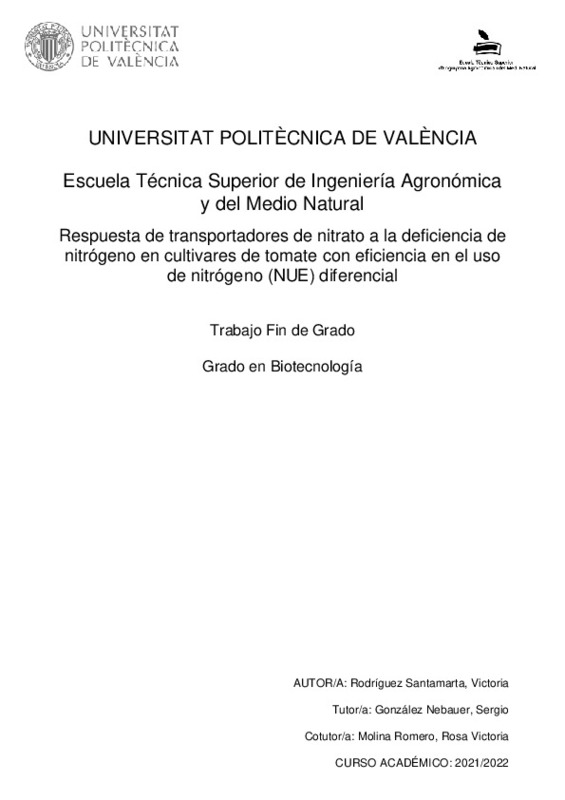|
Resumen:
|
[EN] There is currently great concern about environmental problems. Among these problems is the
excessive use of nitrogen fertilizers to maintain a high yield of crops, and to be able to feed the
current population that ...[+]
[EN] There is currently great concern about environmental problems. Among these problems is the
excessive use of nitrogen fertilizers to maintain a high yield of crops, and to be able to feed the
current population that grows exponentially every year. This overfertilization causes
contamination of soils and aquifers and has contributed to climate change. In addition to
improvements in crop management, in this context, the development of cultivars with greater
efficiency in the use of nitrogen (NUE) is of great importance. Genetic improvement focused on
the development of cultivars with high NUE requires knowledge of the molecular and
physiological bases of the processes that make up the NUE, which can be grouped into absorption
and use of nitrogen. The knowledge of the NUE available so far is restricted to a few species,
mainly Arabidopsis thaliana and rice. Being the tomato one of the most demanded horticultural
crops, both for fresh and canned consumption, it would be crucial to develop genotypes that
require a lower contribution of nitrogen, thus increasing the NUE and being able to considerably
reduce the use of nitrogen fertilizers.
The uptake of N from the soil occurs mainly in the form of nitrates. Numerous nitrate transporters
have been described in Arabidopsis, but little is known about those involved in the uptake of this
molecule in tomato, and especially in mesophilic cells, where it is incorporated mostly in tomato
for assimilation as amino acids. In a previous work of the laboratory, transporters of the NPF
family were identified in Moneymaker tomato that varied their expression under conditions of
limitation in the contribution of N, so they suggested that they could have an important role in the
responses to the deficiency in this macronutrient.
This project studies the existence of differences in vegetative growth between several tomato
genotypes, selected for their differences in NUE, to relate it to the expression in leaves of nitrate
transporters NPF1.17 and NPF2.11. As the most remarkable results of this work, it was obtained,
in the first place, that the cultivars presented very different responses to the lack of nitrogen. It is
noteworthy that N deficiency affected to a lesser extent the growth parameters in genotypes MM
and 82 and that cultivar 32 was the cultivar that was most affected by the decrease in N. In
addition, significant correlations were obtained between the NPF1.17 and NPF2.11 genes with
the parameters studied by varying the contribution of N, being of special importance the positive
correlations that both genes present with the biomass. The NPF2.11 gene showed correlation with
biomass in three of the genotypes studied while the NPF1.17 gene, although its correlation with
biomass was only significant for the MM and 70 genotypes, these have high NUE values and a
high production.
[-]
[ES] El tomate (Solanum lycopersicum L.) es uno de las principales cultivos hortícolas a nivel mundial, y que requiere grandes cantidades de fertilizantes nitrogenados para maximizar su producción. En el contexto actual ...[+]
[ES] El tomate (Solanum lycopersicum L.) es uno de las principales cultivos hortícolas a nivel mundial, y que requiere grandes cantidades de fertilizantes nitrogenados para maximizar su producción. En el contexto actual de cambio climático, se está demandando una reducción del uso de estos fertilizantes, que además contribuirá a la disminución de la contaminación ambiental derivada de su uso masivo. Para minimizar el efecto negativo de esta reducción sobre la producción, se hace necesario el desarrollo de cultivares con elevada eficiencia en el uso del nitrógeno (NUE). Para abordar este proceso de mejora, es necesario tener un mayor conocimiento de los procesos implicados en la asimilación y uso del N por la planta. La NUE es un parámetro fisiológico complejo que engloba procesos de transporte, metabolismo y partición de asimilados nitrogenados en la planta. La captación de N desde el suelo se produce principalmente en forma de nitratos en agricultura. Se han descrito numerosos transportadores de nitrato en Arabidopsis, pero se conoce poco acerca de los implicados en la captación de esta molécula en tomate, y especialmente en las células del mesófilo, donde se considera que es incorporado mayoritariamente en tomate para su asimilación como aminoácidos. En un trabajo previo del laboratorio, se identificaron en tomate Moneymaker unos transportadores de la familia NPF que aumentaban su expresión en condiciones de limitación en el aporte de N, por lo que sugerían que podían tener un papel importante en las respuestas a la deficiencia en este macronutriente. Para confirmar su papel, se pretende estudiar su expresión en diferentes cultivares de tomate que previamente se habían seleccionado como de alta y baja NUE, y con diferencias en su eficiencia en la captación de N. El estudio se realizará en condiciones de aporte suficiente y limitante para determinar su relación con la NUE.
[-]
|







